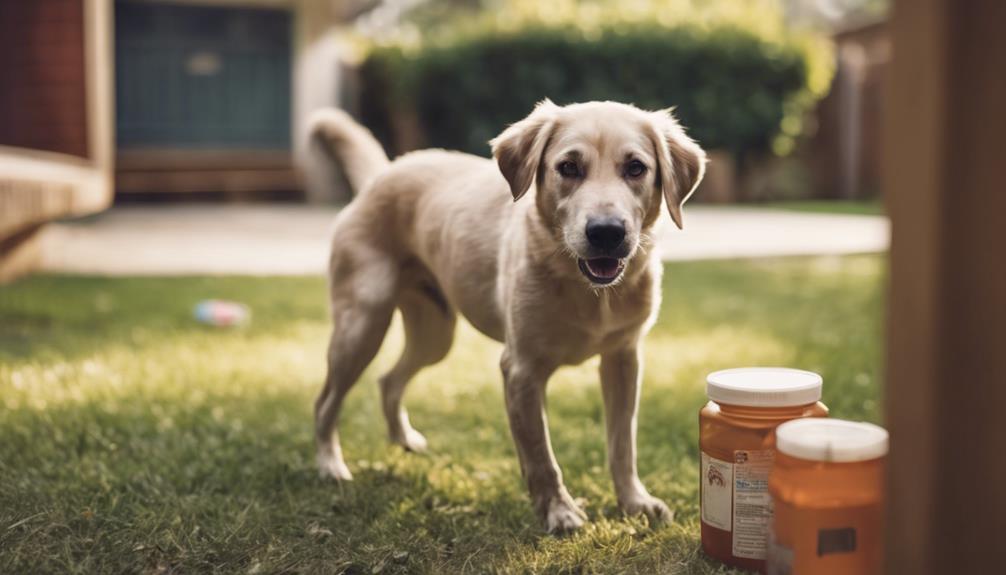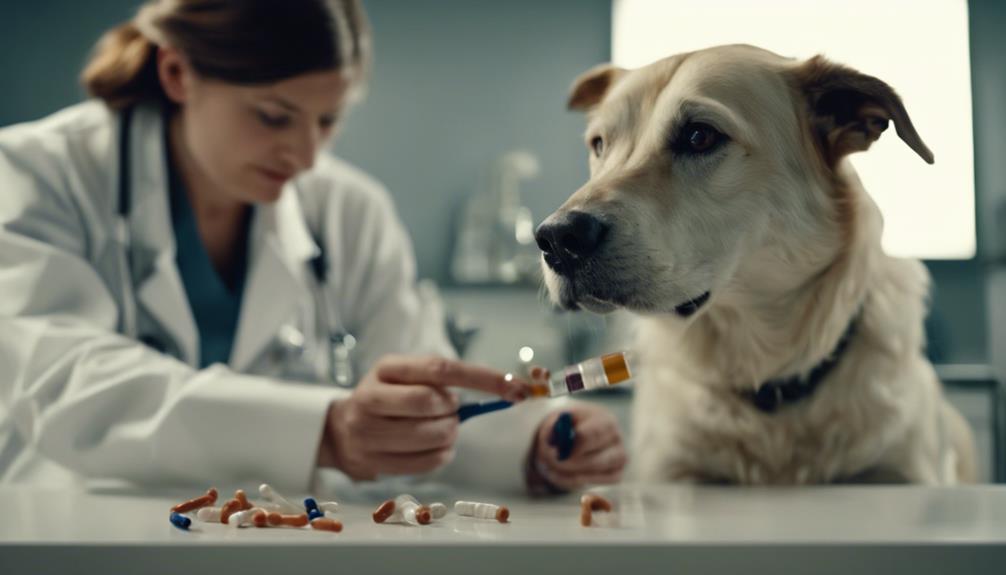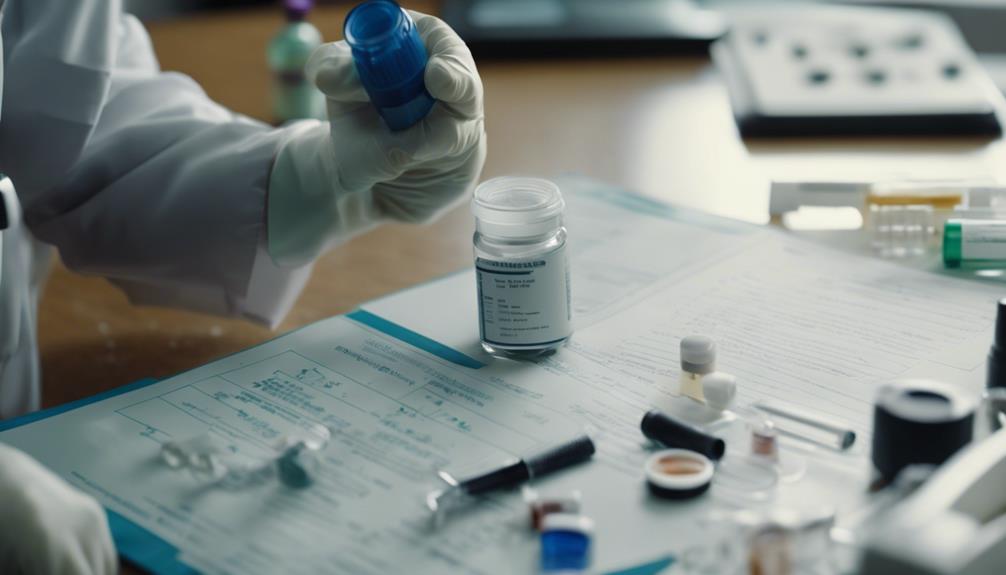Canine health is a paramount concern for pet owners, with whipworms presenting a notable challenge in maintaining the well-being of dogs.
The intricate nature of these parasites and their impact on the gastrointestinal system necessitate a comprehensive approach to treatment and prevention.
Understanding the nuances of whipworm infections, from transmission to effective management, is pivotal in safeguarding the health of our beloved pets.
By exploring the strategies and methods available to combat this parasite problem, dog owners can equip themselves with the knowledge needed to navigate this aspect of canine care successfully.
Key Takeaways
- Consult a vet for suspected whipworm infections in dogs to determine appropriate treatment.
- Regular stool samples may be necessary due to intermittent egg release.
- Extended medication periods are often advised to combat whipworm reinfection risks.
- Owners should promptly clean up dog feces to prevent whipworm transmission and environmental contamination.
Whipworms in Dogs: An Overview
Whipworms, scientifically identified as Trichuris vulpis, are parasitic nematodes that commonly infect dogs, attaching themselves to the mucosal lining of the cecum, colon, and large intestine. These thin worms, typically about one-quarter inch long, cause gastrointestinal irritation and discomfort in infected dogs.
When present in large numbers, whipworms can lead to significant damage within the host's intestinal tract. Symptoms of whipworm infection may include weight loss, chronic diarrhea, dehydration, bloody stools, and anemia. Due to the delayed maturity of whipworm eggs, some dogs may not exhibit immediate signs of infection.
If whipworm infection is suspected, it is crucial to seek veterinary assistance promptly for proper diagnosis and treatment.
Understanding Whipworm Transmission
The mode of transmission for whipworm infections in dogs primarily involves the ingestion of environmentally resistant eggs present in feces. These eggs are shed in the feces of infected dogs and can survive in the environment for extended periods, making them a persistent threat. Once ingested, the eggs hatch into larvae in the dog's intestines, eventually developing into adult whipworms that attach to the mucosal lining of the cecum, colon, and large intestine. Here is a table summarizing key points about whipworm transmission:
| Whipworm Transmission | |
|---|---|
| Primary Mode | Ingestion of eggs in feces |
| Egg Survival | Up to five years |
| Larval Development | Within a month |
| Adult Whipworms | Develop within three months |
Signs of Whipworm Infections

Symptoms indicative of whipworm infections in dogs often include weight loss, chronic diarrhea, dehydration, bloody stools, and anemia. Dogs infected with whipworms may exhibit the following signs:
- Lethargy and weakness
- Vomiting
- Abdominal pain or bloating
- Poor coat condition
These symptoms can vary in severity depending on the extent of the infestation and the dog's overall health. Since some dogs may not display immediate symptoms, it's crucial to monitor their behavior and stool regularly.
If you suspect your dog has a whipworm infection, consult your veterinarian promptly for proper diagnosis and treatment. Early detection and intervention can prevent complications and improve your dog's health outcomes.
Importance of Whipworm Diagnosis
Prompt diagnosis of whipworm infections in dogs is crucial for effective treatment and management. Early detection allows for timely intervention, reducing the risk of complications and ensuring the well-being of the affected dog. Veterinarians employ various diagnostic methods to confirm whipworm infections, such as fecal flotation tests and examining clinical signs. Below is a table summarizing the importance of whipworm diagnosis:
| Importance of Whipworm Diagnosis | |
|---|---|
| Facilitates timely treatment | Helps prevent further health complications |
| Confirms the presence of whipworms | Guides appropriate medication decisions |
| Allows for monitoring of progress | Ensures the well-being of the dog |
Whipworm Prevention Tips

To mitigate the risk of whipworm infections in dogs, proactive preventive measures are essential. Here are some tips to help prevent whipworm infestations:
- Regular deworming: Follow your veterinarian's deworming schedule to target whipworms and other parasites effectively.
- Maintain hygiene: Clean up your dog's feces promptly to reduce the chances of whipworm transmission.
- Prevent scavenging: Discourage your dog from scavenging on potentially contaminated items outdoors.
- Monitor outdoor activities: Supervise your dog during outdoor activities to prevent ingestion of infective whipworm eggs.
Human Safety Concerns
To ensure overall safety and well-being, it is important for dog owners to be aware of potential human health concerns associated with whipworm infections in dogs. While whipworms are primarily a canine parasite and rarely affect humans, there are still some precautions that should be taken.
Whipworm eggs, although unlikely to infect humans, can survive in the environment for long periods, posing a potential risk if accidentally ingested. It is recommended for owners to wear gloves when handling dog feces and to thoroughly wash their hands afterward. Prompt removal of dog feces from the environment is also crucial in preventing any potential human exposure to whipworm eggs.
Seeking Veterinary Consultation

When suspecting whipworm infection in a dog, it is advisable to seek veterinary consultation promptly for accurate diagnosis and tailored treatment. Veterinary expertise is crucial in managing whipworm infections effectively. Here are some reasons why consulting a vet is essential:
- Vets can conduct specific tests to confirm whipworm infection and rule out other potential health issues.
- They can provide personalized treatment plans based on the severity of the infection and the individual dog's health status.
- Vets can offer guidance on preventing reinfestation and maintaining a healthy environment for the dog.
- Regular follow-up consultations can ensure the effectiveness of the treatment and address any concerns promptly.
Diagnostic Challenges and Solutions
Addressing the diagnostic challenges associated with whipworm infections in dogs requires a comprehensive understanding of the varied manifestations and testing intricacies involved. Whipworm infections can be challenging to diagnose due to intermittent egg shedding and the potential lack of clinical signs in some cases. Veterinarians typically rely on fecal examinations to detect whipworm eggs, but multiple samples may be necessary to increase diagnostic accuracy. Additionally, false negatives can occur, necessitating a high level of suspicion and potentially the need for further testing methods. Below is a table summarizing the diagnostic challenges and solutions for whipworm infections in dogs:
| Diagnostic Challenges | Solutions |
|---|---|
| Intermittent egg shedding | Multiple stool samples |
| Lack of clinical signs | High suspicion required |
| False negatives | Consider alternative tests |
Treatment Approaches for Whipworms

Implementing effective treatment strategies is crucial in managing whipworm infections in dogs, aiming to eradicate the parasites and prevent reinfestation.
Treatment approaches for whipworms include:
- Administering specific anthelmintic medications targeting whipworms.
- Following a prescribed treatment schedule to ensure all parasites are eliminated.
- Implementing strict hygiene measures to prevent environmental contamination and reinfection.
- Monitoring the dog post-treatment through regular fecal examinations to confirm parasite clearance.
Managing Whipworm Medication
In the treatment of whipworm infections in dogs, the management of whipworm medication plays a critical role in ensuring the effective eradication of these parasites and minimizing the risk of reinfestation. It is essential to administer the prescribed medication consistently and according to the vet's instructions.
Missing doses or stopping treatment prematurely can lead to incomplete eradication of whipworms, potentially allowing them to multiply and cause further harm to the dog. Additionally, it is crucial to follow up with any recommended retesting to confirm the effectiveness of the treatment.
Proper management of whipworm medication is key to successfully eliminating whipworm infections in dogs and preventing their recurrence.
Developing a Treatment Plan

To effectively combat whipworm infections in dogs, developing a comprehensive treatment plan is essential to address the parasitic infestation and prevent reoccurrence.
When creating a treatment plan for whipworms in dogs, consider the following key aspects:
- Consultation with a Veterinarian: Seek professional guidance to confirm the diagnosis and receive appropriate treatment recommendations.
- Stool Sample Analysis: Multiple stool samples may be necessary to detect intermittent egg shedding and accurately assess the extent of the infestation.
- Long-Term Medication: Extended treatment periods are often required due to the persistent nature of whipworm eggs and the high risk of reinfection.
- Consideration of the Whipworm Life Cycle: Work closely with your vet to tailor the treatment plan based on the stages of the whipworm life cycle.
Addressing Whipworm Reinfection
Addressing Whipworm Reinfection necessitates a strategic approach to manage the persistent threat of recurring parasitic infestations in dogs. To effectively tackle whipworm reinfection, consider the following key strategies:
| Strategy | Description | Importance |
|---|---|---|
| Regular Vet Check-ups | Scheduled check-ups allow for timely detection and treatment of whipworms. | Early intervention helps prevent severe infestations. |
| Environmental Sanitation | Thoroughly clean and disinfect your dog's living areas to remove whipworm eggs. | Reduces the risk of re-infection from contaminated environments. |
| Preventive Medication | Administer preventive medications as recommended by your veterinarian. | Helps to control whipworm populations and reduce recurrence. |
Long-Term Strategies for Prevention

Considering the persistent threat of whipworm reinfection in dogs, implementing long-term prevention strategies is crucial for effectively managing and minimizing parasitic infestations. To safeguard your furry companion from whipworms over the long term, consider the following preventive measures:
- Regular fecal testing and monitoring to detect whipworm eggs early on.
- Maintaining a clean living environment by regularly removing feces from the yard and living areas.
- Administering monthly heartworm preventives that also target whipworm infections.
- Consulting with your veterinarian to establish a tailored deworming schedule based on your dog's risk factors and lifestyle.
Conclusion
In conclusion, whipworms in dogs present a significant health concern that requires diligent monitoring, timely intervention, and preventive measures. Understanding the transmission, signs of infection, and treatment options is essential for safeguarding canine well-being.
By implementing comprehensive prevention strategies and adhering to treatment plans, dog owners can effectively manage whipworm infestations and minimize the risk of reinfection. Prioritizing long-term prevention measures is crucial for ensuring the optimal health and welfare of our canine companions.




